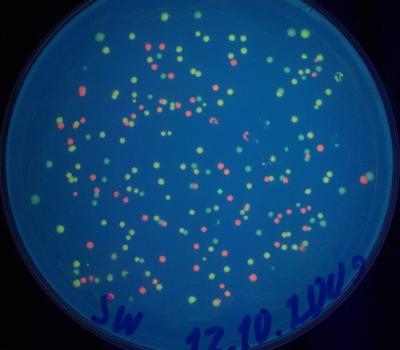Team:Warsaw/results
From 2009.igem.org
Contents |
lacI/cI bistable switch
Control of cell invasion and further operation of our system - the BacInVader is done by two bistable switches. The first one controls expression of invasion genes.
Design
The structure of this switch is shown below:
The most important components of the switch are repressor proteins cI (denoted here as cIts, see explanation below) and lacI. The whole device is composed of two main parts:
LacI under control of 'cI lam' promoter
and
cI under control of Plac promoter
How it works?
Because cI is repressor of 'cI lam' promoter and lacI is repressor of Plac promoter (denoted here as 'LacI') there are only two mutually exclusive states of the switch:
- Plac promoter is active which leads to cI expression. CI binds to 'cI lam' promoter and represses it so no genes under this promoter are expressed.
- 'cI lam' promoter is active which leads to LacI expression. LacI binds to Plac promoter and represses it.
According to this, state of the switch should be stable in time until some external stimulus is applied.
How to switch its state?
To set the state of the switch 0,1mM IPTG and high temperature (42oC) are used.
- After addition of 0,1mM IPTG LacI gets inactivated and transcription from Plac starts. cI is expressed which leads to repression of 'cI lam' promoter.
- Heating the bacteria in 42oC inactivates CI protein and starts expression from 'cI lam' promoter.
Experimental results
To test if our assumptions are correct we have assembled switch testing device . In this device we have connected GFP with Plac dependent part of the switch and mRFP with 'cI lam' dependent part. After transformation of the complete construct at 30oC random distribution of green and red colonies was observed:
It was expected because we haven't used temperature nor IPTG to set the initial state of the switch.
We have cultured green colonies in 42oC and they started to express RFP. Red colonies were grown in liquid culture and on plates in 30oC with 0,1mM IPTG and they turned green (GFP+ phenotype). It indicates that our lacI/cI bistable switch works as expected.
To test stability of the states both red and green colonies were grown in liquid culture in 30oC. The 'red' ('cI lam' promoter active) state remained stable for about 9 hours. After that time cI repressor took over and bacteria started to express GFP. The 'green' (Plac promoter active) state was stable after overnight culture. Spontaneous switching from red to green wasn't observed on plates, where incubation period of 36 hours didn't lead to change of state.
We conclude that level of LacI production may be to low to enshure complete repression of Plac when cells are growing rapidly in liquid medium. This results in 'leaking' of Plac promoter and accumulation of CI protein which eventually leads to state switching. Improved versions of this device should have stronger RBS before lacI and/or use Plac promoter with more lac operator sequences to ensure that leaking of Plac will be minimized.
Bistable switch parameters
Current version of our cI/lacI bistable switch has following parameters:
- Temperature of stable state: 30oC
- Strain requirements: strain should be lacI deficient
- Plac->'cI lam' switching: in 42oC
- 'cI lam' -> Plac switching: in 0,1 mM IPTG
- State stability in plate culture: >36h for both states
- State stability in liquid culture: ~9h for 'cI lam' driven (red) state; >18h for Plac driven (green) state
 "
"
